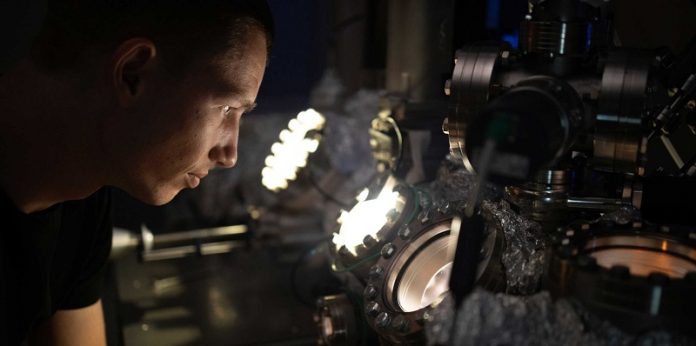
Researchers at ETH Zurich have discovered a new method to control quantum states of single electron spins using electron currents with aligned spins.
This innovative approach could revolutionize the way electronic circuits and quantum devices operate in the future. The findings were published in the journal Science.
Electrons, tiny particles that make up atoms, have a property called spin, which makes them act like tiny magnets aligning along a magnetic field.
This spin, along with the electron’s electric charge, influences its behavior in electronic circuits. In modern technology, electron spins are increasingly used for data storage and processing.
One example of spin-based technology is MRAM (magnetic random access memory). MRAM uses many aligned electron spins to store information.
The aligned spins, or spin-polarized currents, can change the magnetization at specific points in a material.
Pietro Gambardella and his team at ETH Zurich have shown that spin-polarized currents can also control the quantum states of single electron spins.
This discovery could be significant for future technologies, particularly in managing quantum bits (qubits) in quantum computers.
Traditionally, electron spins are manipulated using electromagnetic fields like radio waves or microwaves. This method, known as electron paramagnetic resonance, has been used since the mid-1940s in various fields such as materials research, chemistry, and biophysics.
While this technique has been applied to single atoms, the exact mechanism was not well understood.
To better understand these processes, the researchers studied pentacene molecules placed on a silver surface with a thin layer of magnesium oxide. This setup ensured that the electrons in the molecule behaved as they would in free space. Using a scanning tunneling microscope, the researchers measured the tunnel current—electrons moving quantum mechanically between the microscope tip and the molecule.
Quantum mechanics allows electrons to “tunnel” through a gap even when they don’t have enough energy to cross it by classical physics standards. This tunneling creates a measurable current.
The researchers enhanced the tunnel current by adding a few iron atoms to the tungsten tip of the microscope, creating a miniature magnet. When a current flows through this magnet, the electron spins align with its magnetization.
By applying a constant voltage and a fast-oscillating voltage to the magnetized tip, the researchers observed characteristic resonances in the tunnel current. These observations helped them understand the interactions between the tunneling electrons and the pentacene molecule.
The data revealed two key insights. First, the electron spins in the pentacene molecule reacted to the electromagnetic field similarly to traditional electron paramagnetic resonance.
Second, an additional process, known as spin transfer torque, influenced the electron spins in the molecule. Spin transfer torque changes the spin of a molecule under the influence of a spin-polarized current without using an electromagnetic field.
The researchers demonstrated that this method could create quantum superposition states, essential for quantum technologies.
“This new method of controlling spins with spin-polarized currents at the quantum level opens up many potential applications,” says Ph.D. student Stepan Kovarik. Unlike electromagnetic fields, spin-polarized currents can be controlled very precisely, down to less than a nanometer.
This precision could allow for highly accurate control of quantum states in electronic circuits and quantum devices, making this a significant step forward in quantum technology.
Source: ETH Zurich.



